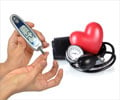Risk of COVID-19 decreases with control of hypertension
- Hypertension affects more than a billion people worldwide
- Recent study suggests that BP above 150/90mmHg significantly increases risk of COVID-19 infection
- Patients with uncontrolled BP also had higher risk of mortality regardless of other factors like age, ethnicity and obesity
What is Hypertension?
Hypertension, also known as elevated blood pressure, is a serious medical condition that significantly increases the risks of heart, brain, kidney, and other diseases. It affects more than billion people worldwide. It leads to premature mortality and morbidity.Uncontrolled Blood Pressure and Mortality due to COVID-19
“We found that in those with diagnosed hypertension, the risk of COVID-19 significantly increased once the high number exceeded 150 mmHg or the low number exceeded 90 mmHg compared to a target blood pressure (120-129/80-89 mmHg),” said lead author Holly Pavey, a doctoral student at the University of Cambridge in the United Kingdom.The research found people with uncontrolled high blood pressure are more likely to be admitted to the hospital and die from a COVID-19 infection, regardless of other known risk factors such as age, ethnicity, or obesity (1✔ ✔Trusted Source
Hypertension and Excess Risk for Severe COVID-19 Illness Despite Booster Vaccination
Go to source).
The study was able to be more specific because of the inherent integration in the UK National Health Service. That level of data sharing allows access to ‘really granular data on long-term blood pressure control for their patients,’ said Dr. Joseph Ebinger, an assistant professor of cardiology and director of clinical analytics of the Smidt Heart Institute at the Cedars-Sinai Medical Center in Los Angeles.
“They found it’s not just the diagnosis of high blood pressure — yes or no — but that the risk goes up as your systolic blood pressure goes up, which is really a measure of lack of control,” said Ebinger.
What is Normal Blood Pressure?
‘Normal’ blood pressure readings are typically 120 mmHg systolic (upper reading) over 80 mmHg diastolic (lower reading), according to the US Centers for Disease Control and Prevention.Unfortunately, many people fail to properly control their blood pressure, even after they have been diagnosed and are on medication, Ebinger added.
“It’s estimated that less than half of individuals with a diagnosis of high blood pressure actually have control over their hypertension, so this is a big problem,” he said. “That’s due to a myriad of factors: underdiagnosis, lack of awareness, medication nonadherence and undertreatment.”
On the positive side, successfully reducing blood pressure through medication was linked with a corresponding reduction in risk for severe COVID-19, the new study found.
“It is really important for individuals to have regular blood pressure checks and for doctors to try and get their patients’ blood pressure controlled,” researchers said.
“Controlling the blood pressure to target levels is important, irrespective of the type of treatment used to achieve it,” she said. “Ultimately blood pressure control will help to reduce the risk of suffering severely from new strains of COVID-19 or other viruses in the future.”
Doctors used to target a blood pressure reading of less than 140/90 to control risk for cardiovascular disease and death. Then, in 2015, results of SPRINT, or the Systolic Blood Pressure Intervention Trial, were published in The New England Journal of Medicine — findings that changed the thinking of many medical professionals.
The SPRINT research found targeting a blood pressure below 120 systolic (the top number) in people with hypertension — but no diabetes — prevented the most cases of heart disease and death. There were some side effects, however, including a “higher rate of acute kidney injury or acute renal failure in the intensive-treatment group,” according to the trial.
“That possibility was concerning when it came to the elderly, who often have multiple chronic diseases such as type 2 diabetes, kidney concerns and more,” Ebinger said. “So, in 2017, the American College of Cardiology and American Heart Association guidelines shot the gap and set the guideline of a systolic reading less than 130 and a diastolic of less than 80,” Ebinger said. “And this is where some of the debate starts to come in between different types of doctors. Cardiologists believe lower is better. We want to push that number down as much as we can.
“Some primary care doctors and geriatricians might say, ‘You know what, that may not be the best thing for some of my patients,’ and they’re going to treat to a higher number,” he said. “This is where clinical practice and some of the guidelines don’t always add up.”
Stages of Hypertension According to the US Food and Drug Administration
- A typical normal blood pressure is 120/80 or lower.
- Readings between 120/80 and 129/89 are considered pre-hypertension, meaning it’s not as low as it should be but is not yet considered high blood pressure medically.
- Blood pressure is a stage 1 if it reads 130/80.
- Blood pressure of 140/90 or higher is considered stage 2 hypertension.
Reference:
- Hypertension and Excess Risk for Severe COVID-19 Illness Despite Booster Vaccination - (https://www.ahajournals.org/doi/full/10.1161/HYPERTENSIONAHA.122.19694)
Source-Medindia
















